Cultivating BiodiverCity and Climate Resilience - October Issue
Dear EcoSpark volunteers and nature seekers,
Welcome to the October 2025 edition of Cultivating BiodiverCity and Climate Resilience!
As the planet shifts on its axis, the days get shorter and trees, plants, animals and birds begin preparing for the winter ahead. Whether we are looking in streams and rivers, in gardens or valleys and forests, or in the sky above us, we see nature following the cycles of time. The blooms of spring and summer are gone, leaves are changing colour and falling, and the birds are migrating - heading for warmer climates to the south.
Humans are preparing for the next seasons too. Wearing long pants and sweaters, we head to our yards to clean up and prepare our gardens for the winter ahead. Did you know that the actions we take will have an impact on the breeding and survival of birds in the spring! Those migrating birds need to feed their young the arthropods - caterpillars, spiders and other insects - that overwinter here with us. Many of those bugs winter in the leaf litter around our homes and raking now can reduce their populations and diversity by 40 to 50%.
Save the arthropods, feed the chicks! Clean your walkways but leave the leaf litter in your garden and on your lawn, it is a great way to protect biodiversity and will give you more time to discover and observe the cycles of nature!
In this issue we will help you explore some of the most common birds, mammals, reptiles & amphibians, trees & shrubs, wildflowers, fungi, and insects you can find in natural spaces around us at this time of year.






Birds
October is a busy month for migrating bird species. During this month, you’re likely to observe many common migrating birds on their stopovers from their breeding grounds in Northern Canada and Alaska to their feeding grounds in the Southern United States and Latin America. You may catch some waterfowl like Canada Geese (Branta canadensis) overhead in their iconic V shape as they head southward. Turkey Vultures (Cathartes aura) begin their annual flight to the Caribbean, Georgia and Florida, and will be spotted in places like High Park. Other birds you may be able to spot during this period include the White-throated Sparrow (Zonotrichia albicollis), Yellow-Rumped Warbler (Setaphaga caronata), Golden-crowned Kinglet (Regulus satrapa) and Ruby-crowned Kinglet (Corthylio calendula). Lastly, don’t forget night-flights! Many songbirds migrate at night guided by stars and the Earth's magnetic field. On clear October nights, you might hear their faint calls as they pass overhead. Turning off your lights during these peak migration periods can reduce window collisions. Using BirdCast can help you predict nightly migration activity in your area.
How can you help migrating birds this Fall?
Keep your feeders full, especially with high-fat foods like suet and black-oil sunflower seeds.
Turn off outdoor lights at night to reduce window collisions.
Support habitat conservation by volunteering or donating to local nature groups.
Mammals
October is a month of preparation for many mammals. Some, like Big Brown Bats (Eptesicus fuscus), will soon begin hibernation, so this is your last chance to spot them until spring. These bats roost in tree cavities, barns, and old buildings, emerging at dusk to feed on flying insects before the cold sets in. They’ve been observed in places like High Park and Rouge Park, where they play an important role in controlling insect populations.
Other mammals, such as Groundhogs (Marmota monax) and Eastern Gray Squirrel (Sciurus carolinensis), are busy foraging and caching food to prepare for winter. Groundhogs are often found in grassy areas near highways north of Spanbridge Road and south of Eglinton Avenue. Young White-Tailed Deer (Odocoileus virginianus) are losing their spots as they mature, often seen in ravines, parks, and rural edges around the city.
If you’d like to help local mammals this fall, leave out brush piles or logs to offer shelter, and keep your garbage secure to avoid attracting unwanted visitors.





Reptiles & Amphibians
While some birds fly south and the mammals are busy stocking, reptiles and amphibians are preparing for their own seasonal shift: hibernation (or more accurately, brumation for cold-blooded animals). During this period you might see DeKay’s Brownsnakes (Storeria dekayi), Eastern Red-Backed Salamanders (Plethodon cinereus), and the Common Garter Snake (Thamnophis sirtalis) preparing their hibernation spots, called hibernacula, in dead trees, or under rock piles in ravines and parks like Evergreen Brick Works in Toronto’s Don Valley. If you spot a hibernaculum, make sure to leave it undisturbed. Some turtles, like Snapping Turtles (Chelydra serpentina), can be seen on the edges of rivers, streams and ponds. Others, like the Northern Map Turtle (Graptemys geographica), often spend time at the bottom of lakes and deep rivers.
Wetlands are key to the survival of reptiles and amphibians and historically Toronto had an abundance of wetland ecosystems. However, the Toronto and Region Conservation Authority (TRCA) says that over 85% of Toronto’s wetlands have been destroyed due to habitat degradation caused by urban expansion. Habitat degradation results in habitat fragmentation, where ecosystems are spliced up between urban developments, leading to threats from cars and loss of food. Urban expansion also leads to higher levels of pollution that impact the key areas where amphibians and reptiles live, causing infertility. Reptiles and amphibians are vital parts of the ecosystem because they keep our waterways clean and control the insect population. They are also the primary prey of many mammals such as Raccoons and Skunks, as well as many birds. Leaving leaf litter and logs undisturbed provides crucial winter shelter and insulation for frogs, toads, snakes, and other wildlife, protecting them from predators and the cold.






Trees & Shrubs
October is the season of colour for many trees and shrubs. Fall colours include the yellows of the Norway Maple (Acer platanoides), Poplars (populus), and Red Ash (Fraxinus pennsylvanica); reds and oranges of Dogwoods (Cornus), Chokeberry (Aronia), Serviceberry (Amelanchier), and Black Alder (Alnus glutinosa). The Common Buckthorn (Rhamnus cathartica), while turning into a beautiful dark green in October, is actually an invasive species from Europe and parts of Asia. To help newly established trees, you can water their roots before the ground freezes to help them survive winter.


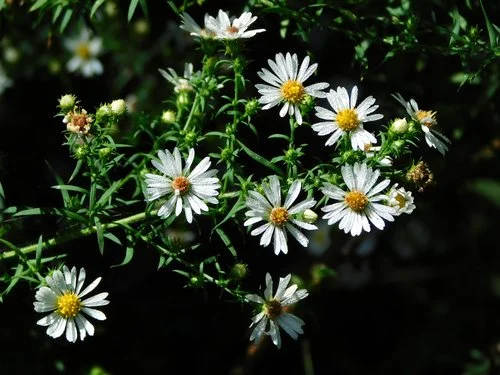
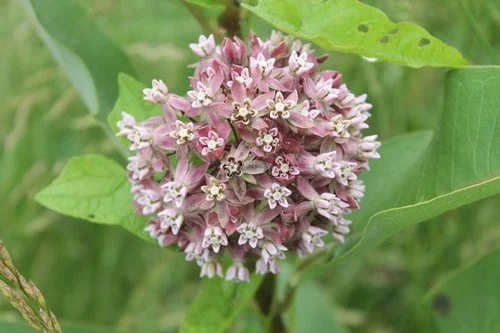
Wildflowers
Wildflowers are prominent in many green spaces in Toronto, think High Park, Evergreen Brick Works, and Christie Pits. Some beautiful white wildflowers include the Panicled Aster (Symphyotrichum lanceolatum), the Multiflora Rose (Rosa multiflora), the Guelder-Rose (Viburnum opulus), and the Hairy White Oldfield Aster (Symphyotrichum pilosum). Take a look at their distinct petals to differentiate these different flowers. To support your local wildlife, leave the dead flowers and plant stems in your garden over the fall to provide important winter habitat for bees and other beneficial insects.
Some common perennials, like the New England Aster (Symphyotrichum novaeangliae) and Common Milkweed (Asclepias syriaca), are still in their blooming period. These plants are rich food sources for monarchs and bees. Monarchs will use them to fuel up before their flight south over Lake Erie, while some queen bees will fatten up for hibernation.




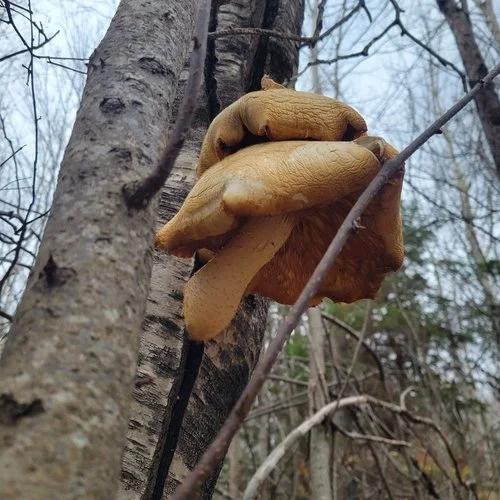
Fungi
Fungi take many shapes and forms in Toronto, from the large Giant Puffball (Calvatia gigantea), very accurately described by its name taking the form of a large white ball, to the Turkey-Tail (Trametes versicolor), resembling the pattern of a turkey’s back feathers. Other mushrooms to keep an eye out for include the Dryad’s Saddle (Ceriporus squamosus), Shaggy Mane (Coprinus comatus), and Elm Mushroom (Hypsizgus ulmarius), which, like their name suggests, uses elm trees as a host.
Mushrooms play an essential role in ecosystems, decomposing dead organic matter (detritus matter) like dead plants, animal remains, and microorganisms to return the energy and nutrients to the soil and in turn the rest of the ecosystem. Without mushrooms and other decomposers, ecosystems would fall apart.


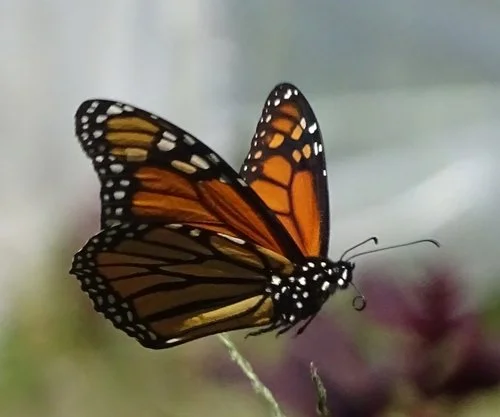
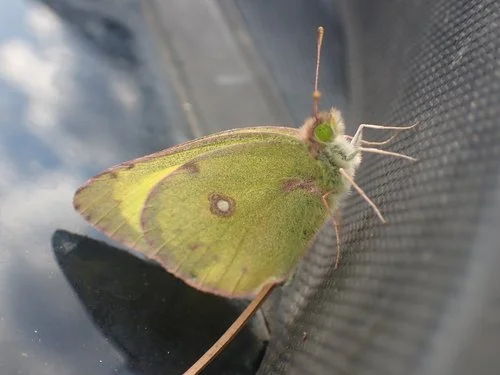
Insects
As the weather cools in October, many insects slowly become less active. While small, they play a vital role in the world around us. Keep an eye out for pollinators like the Common Eastern Bumblebee (Bombus impatiens), one of the most common bumblebee species in Toronto (out of the over 360 species present!) and the Common Drone Fly (Eristalis tenax), who transfer pollen on their hairy bodies from one flower to the next as they feast on the nectar of flowers.
Also keep an eye out for moths and butterflies, of the order Lepidoptera, meaning ‘scaly wings’. Particular species include the Monarch Butterfly (Danaus plexippus), before they begin their winter migration to Mexico, the Isabella Tiger Moth (Pyrrharctia isabella), who prefer to spend winter in Toronto, and the Clouded Sulphur (Colias philodice), who migrate to Missouri and North Carolina. Butterflies and moths are also pollinators, transferring pollen on their hairy legs.
Toronto’s Pollinator Protection Strategy seeks to create and invest in more green spaces for native pollinators and protect pollinators from:
Foraging habitat loss
Loss of larvae host plants
Nesting habitat loss
Overwintering habitat loss
Pesticides
Invasive species
Disease and pests
Climate change
This month you can join EcoSpark for a Walk on the Wild Side. We’re raising funds to bring more high-quality outdoor education programs to schools that lack the funding to experience them. Check out our upcoming walks below.
Group Science Adventure Walk through King’s Mills Park North — SAT Oct 18, 2025 — 10:30 AM
Group Walk - Exploring Biodiversity in G Ross Lord Park - SUN Oct 19, 2025 - 10:30 AM
Group Walk: Species identification in Tommy Thompson Park — SAT Oct 25, 2025 — 10:30 AM
Guided group walk exploring nature in Cullen Bryant Park - SUN Oct 26, 2025 - 10:00 AM
Other Biodiversity events happening this month:
Salmon walk at Morningside Park on October 11th - Learn about the adventures of a salmon through its life cycle!
Fall Colours at Kortright on October 13th - Enjoy a self-guided walk and learn about nature in the fall!
Owl Prowl at Tommy Thompson Park on October 18th - Learn about different species of owls in the GTA!
Accessible Birding at Downsview Park on October 15th - Discover the joy of birding at this free, accessible event!
Save The Birds: A Local Perspective on Bird-Window Collision Prevention at Toronto Public Library - Brentwood Branch on October 15.
All About Bats at the Toronto Botanical Garden on October 30th.
Pumpkins for STEM - Submit your nature themed pumpkin to @EcoSpark_Env for a chance to win a set of field guides!
Have a spooky October!
The EcoSpark Team
Your monthly observations contribute essential data for understanding Toronto's urban biodiversity patterns. Record your findings on iNaturalist to support ongoing research into phenology, species distributions, and ecosystem relationships within our urban environment.
Primary Sources (Toronto Biodiversity Series):
City of Toronto. (2020). Birds of Toronto: A Guide to their Remarkable World (2nd edition). Toronto Biodiversity Series. https://www.toronto.ca/wp-content/uploads/2020/05/8ea3-City-Planning-Birds-of-Toronto-Biodiversity-Series.pdf
City of Toronto. (2016). Mammals of Toronto: A Guide to their Remarkable World (Parts 1 & 2). Toronto Biodiversity Series.
City of Toronto. (2016). Reptiles and Amphibians of Toronto: A Guide to their Remarkable World. Toronto Biodiversity Series.
City of Toronto. (2016). Trees, Shrubs and Vines of Toronto: A Guide to their Remarkable World. Toronto Biodiversity Series.
Additional Sources:
Arsenault, M. (2023, January 12). How snakes overwinter. Wildlife Preservation Canada. Retrieved October 1, 2025, from https://wildlifepreservation.ca/blog/how-snakes-overwinter/
Ramos, D. (2025, June 23). How groundhogs made the DVP their home in the heart of Toronto traffic. Toronto Today. Retrieved October 1, 2025, from https://www.torontotoday.ca/local/environment-climate/dvp-heres-how-groundhogs-made-expressway-home-10835683#:~:text=How%20groundhogs%20made%20the%20DVP,more%20sense%2C%E2%80%9D%20Koprivnikar%20said
Windmuller, D. (2023). New England Aster. Pollinator Garden. Retrieved October 1, 2025, from https://www.pollinatorgarden.ca/product-page/new-england-aster#:~:text=Deep%20purple%20flowers%20offer%20rich,and%20produce%20even%20more%20flower







